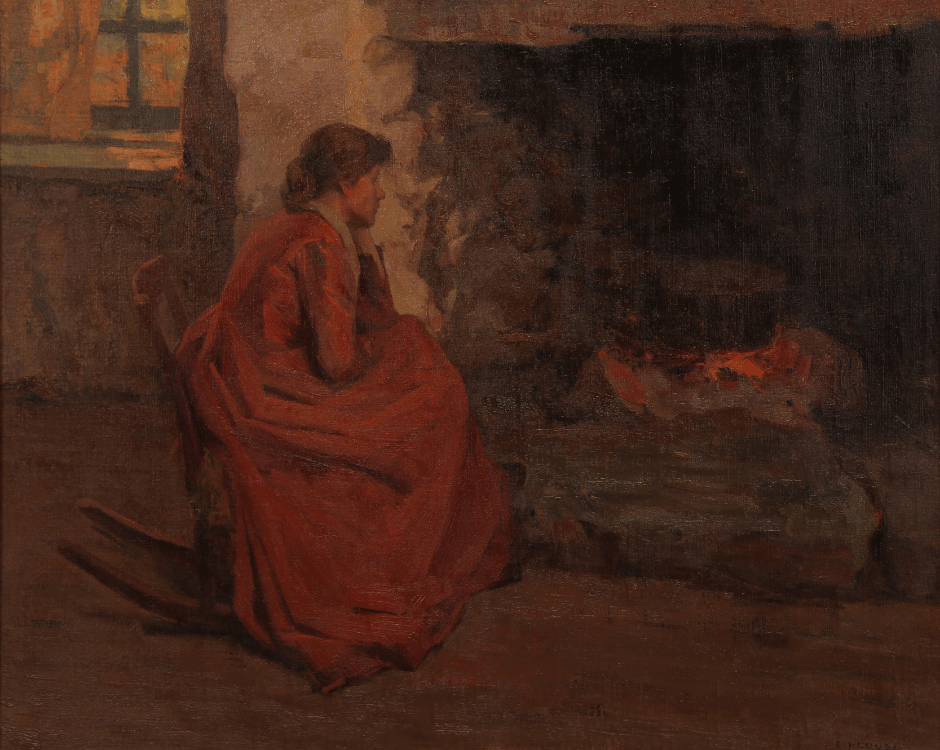Virginia Walker Couse by Fireplace

Virginia Walker Couse by Fireplace, n.d.
Eanger Couse (1866–1936)
Oil on canvas
Listen
Read
Eanger Couse attended prestigious art schools in Chicago, New York, and Paris. In
Paris, he studied with the popular artist William-Adolphe Bouguereau, known for a
neoclassical style inspired by ancient Greece and Rome.
In the late 1700s, world travel—called the Grand Tour—revived popular interest in
the classical antiquity of Greece and Rome. Artists adopted subjects such as virtue,
mythology, heroism, and nationalism, with figures painted in an idealized way.
In the mid-1800s, Bouguereau painted in this style to great success, despite it being
seen by that time as rigidly traditional. Instead, artists were using realism to depict
modern life. Looking at Couse’s painting, we can imagine he may have learned from
Bouguereau how to paint the human body and how to use light to convey serenity.
Couse met his wife, Virginia, at school in Paris and afterward adopted life on her
family’s ranch in Washington State near the border of Oregon. Eanger and Virginia
lived and worked back and forth on the west and east coasts of the United States and
in France. Eventually, a visit to Taos, New Mexico led them to permanent residency
there in the early 1900s. After relocating to Taos, Couse became the founding president
of the Taos Society of Artists.
Continue reading to enjoy a reflection by Heritage and Museum Science graduate student
Victoria Hutchison:
The painting of Virginia sitting by the fireplace depicts a simple act of life. Couse
often painted Native Americans in solitude in their homes or in natural spaces. In
this painting of his wife, Couse’s subject differs but conveys the same simplicity
of quiet activity in a comforting and peaceful environment.
Another artist who painted moments of absorption in a similar artistic style is Henry
Ossawa Tanner. Tanner was an African American artist from Pennsylvania, who worked
in France in the late 1800s and early 1900s and painted in the European Realist style.
Tanner is known for depicting the dignity of ordinary life. For example in his painting,
The Thankful Poor, an African American grandfather and grandson sit at a kitchen table
appearing to pray before a sparse meal. Tanner’s painting, like Couse’s, conveys quietude
and simplicity in domestic life.
Explore
See an image of The Thankful Poor and learn more about Henry Ossawa Tanner and the Realist style that influenced Eanger
Couse: here.
See Eanger Couse’s typical work and learn about his Taos home: here.
Survey
Share your voice to help the Museum create the next long-term exhibition from the
Diamond M Collection when it returns in 2024 to the Diamond M galleries. Your responses
will be used to explore possible exhibition themes and artworks for future display.
Completing a short survey by clicking here.
Snap a selfie with your favorite piece and tag it to #museumTTYOU.
Back to Gallery Guide
**Please note the images of artworks and texts in this gallery guide are provided as fair use of copyrighted materials. It is your responsibility to obtain any copyright permissions that may be required for your further use of these materials. To request images, please contact the Museum Registrar.
Museum at Texas Tech University
-
Address
3301 4th Street, Lubbock, TX 79415 -
Phone
806.742.2490 -
Email
museum.texastech@ttu.edu
